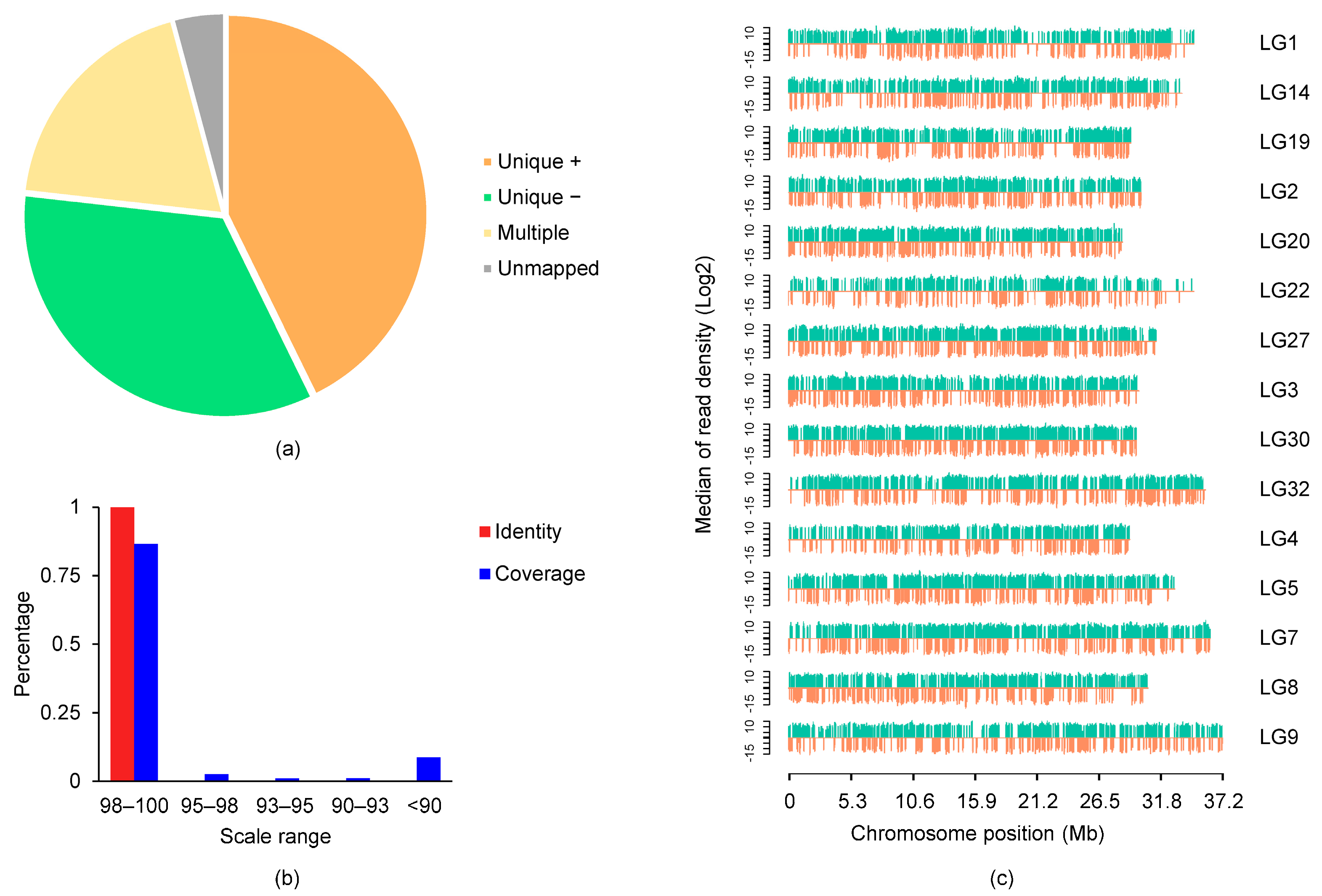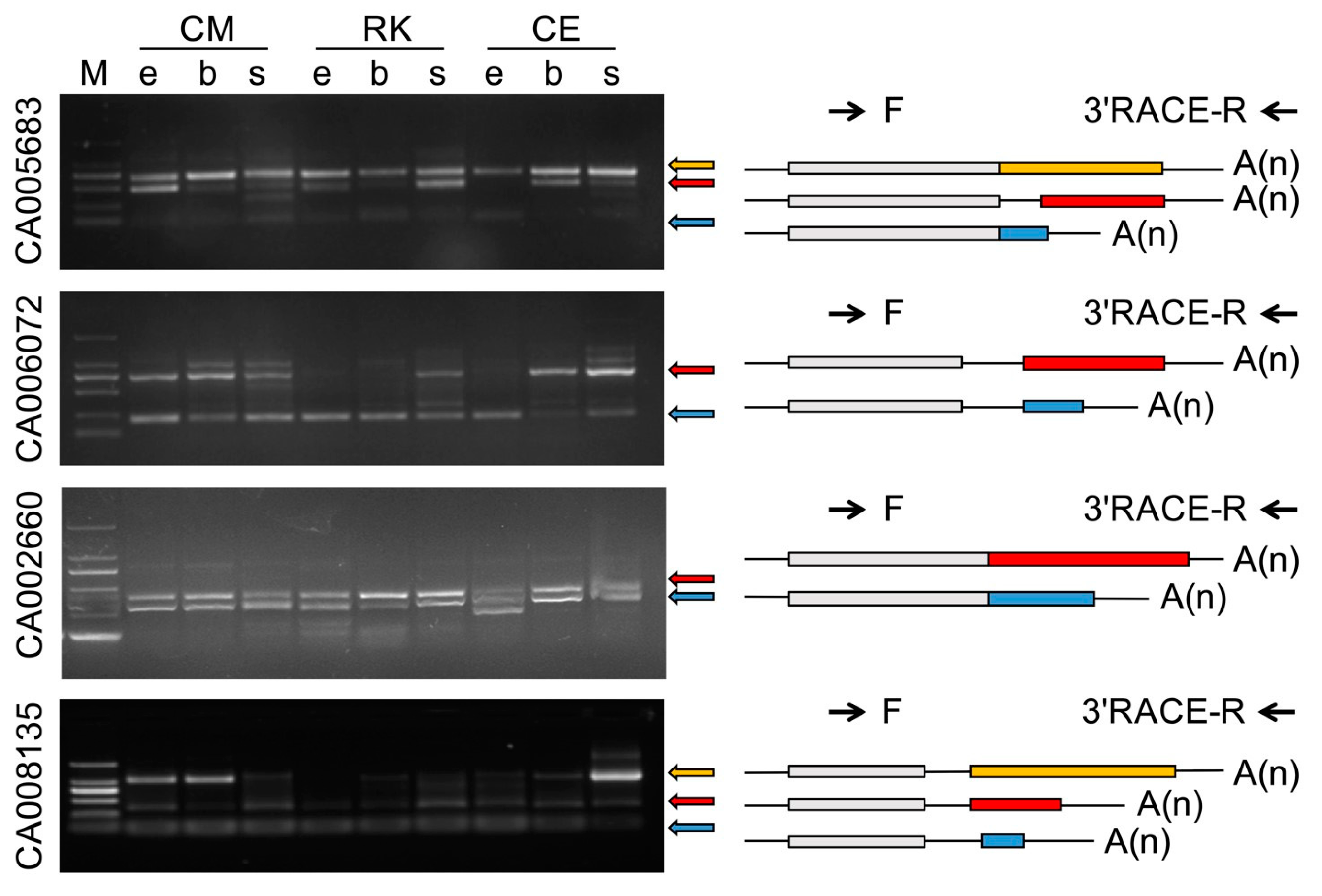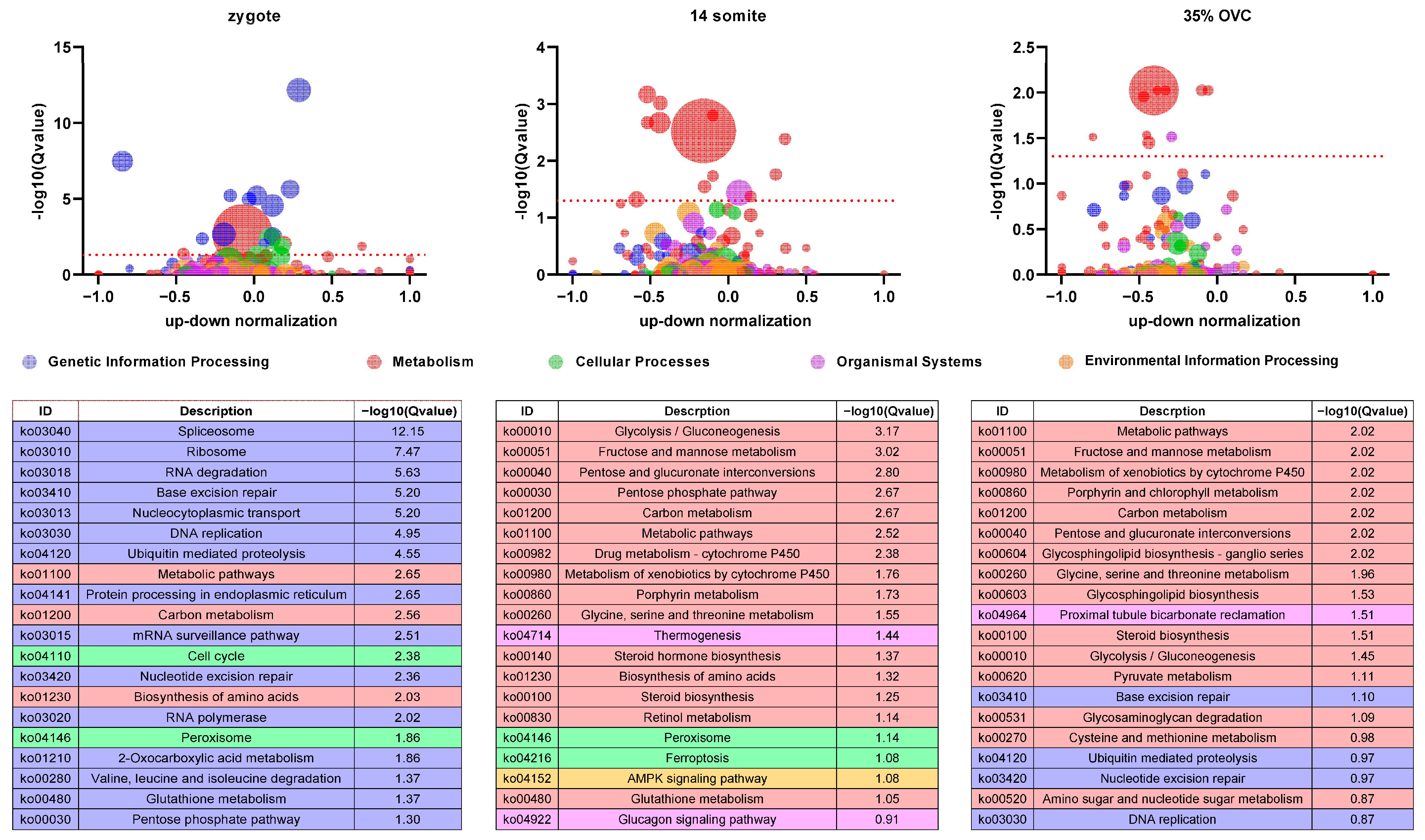Full-Length RNA Sequencing Provides Insights into Goldfish Evolution under Artificial Selection
Abstract
1. Introduction
2. Results
2.1. Whole Length Transcript Profile of Goldfish Embryos
2.2. Alternative Splicing Analysis
2.3. Alternative Polyadenylation Analysis
2.4. Long Non-Coding RNAs
2.5. Gene Fusions
2.6. Differentially Expressed Genes between Celestial-Eye and Ryukin
2.7. DEGs Enrichment Analysis
3. Discussion
4. Materials and Methods
4.1. Fish Samples
4.2. Artificial Fertilization
4.3. Total RNA Preparation and Transcriptome Sequencing
4.4. Sequencing Data Processing
4.5. KEGG Enrichment Analysis
4.6. RT-PCR Analysis
Supplementary Materials
Author Contributions
Funding
Institutional Review Board Statement
Informed Consent Statement
Data Availability Statement
Acknowledgments
Conflicts of Interest
References
- Komiyama, T.; Kobayashi, H.; Tateno, Y.; Inoko, H.; Gojobori, T.; Ikeo, K. An Evolutionary Origin and Selection Process of Goldfish. Gene 2009, 430, 5–11. [Google Scholar] [CrossRef] [PubMed]
- Wang, S.-Y.; Luo, J.; Murphy, R.W.; Wu, S.-F.; Zhu, C.-L.; Gao, Y.; Zhang, Y.-P. Origin of Chinese Goldfish and Sequential Loss of Genetic Diversity Accompanies New Breeds. PLoS ONE 2013, 8, e59571. [Google Scholar] [CrossRef] [PubMed]
- Tsai, H.; Chang, M.; Liu, S.; Abe, G.; Ota, K.G. Embryonic Development of Goldfish (Carassius auratus): A Model for the Study of Evolutionary Change in Developmental Mechanisms by Artificial Selection. Dev. Dyn. 2013, 242, 1262–1283. [Google Scholar] [CrossRef] [PubMed]
- Ota, K.G.; Abe, G. Goldfish Morphology as a Model for Evolutionary Developmental Biology. WIREs Dev. Biol. 2016, 5, 272–295. [Google Scholar] [CrossRef] [PubMed]
- Ye, Q.; Qu, L. Goldfish of China; Straits of Publishing and Distributing: Fuzhou, China, 2017. [Google Scholar]
- Wang, C. The Origin of the Goldfish. Bull. Biol. 1985, 12, 11–13. [Google Scholar]
- Li, I.; Chang, C.; Liu, S.; Abe, G.; Ota, K.G. Postembryonic Staging of Wild—Type Goldfish, with Brief Reference to Skeletal Systems. Dev. Dyn. 2015, 244, 1485–1518. [Google Scholar] [CrossRef]
- Chen, Z.; Omori, Y.; Koren, S.; Shirokiya, T.; Kuroda, T.; Miyamoto, A.; Wada, H.; Fujiyama, A.; Toyoda, A.; Zhang, S.; et al. De Novo Assembly of the Goldfish (Carassius auratus) Genome and the Evolution of Genes after Whole-Genome Duplication. Sci. Adv. 2019, 5, eaav0547. [Google Scholar] [CrossRef]
- Chen, D.; Zhang, Q.; Tang, W.; Huang, Z.; Wang, G.; Wang, Y.; Shi, J.; Xu, H.; Lin, L.; Li, Z.; et al. The Evolutionary Origin and Domestication History of Goldfish (Carassius auratus). Proc. Natl. Acad. Sci. USA 2020, 117, 29775–29785. [Google Scholar] [CrossRef]
- Abe, G.; Lee, S.-H.; Chang, M.; Liu, S.-C.; Tsai, H.-Y.; Ota, K.G. The Origin of the Bifurcated Axial Skeletal System in the Twin-Tail Goldfish. Nat. Commun. 2014, 5, 3360. [Google Scholar] [CrossRef]
- Abe, G.; Lee, S.; Li, I.; Ota, K.G. An Alternative Evolutionary Pathway for the Twin—Tail Goldfish via Szl Gene Mutation. J. Exp. Zool. Mol. Dev. Evol. 2018, 330, 234–241. [Google Scholar] [CrossRef]
- Letelier, J.; de la Calle-Mustienes, E.; Pieretti, J.; Naranjo, S.; Maeso, I.; Nakamura, T.; Pascual-Anaya, J.; Shubin, N.H.; Schneider, I.; Martinez-Morales, J.R.; et al. A Conserved Shh Cis-Regulatory Module Highlights a Common Developmental Origin of Unpaired and Paired Fins. Nat. Genet. 2018, 50, 504–509. [Google Scholar] [CrossRef]
- Kon, T.; Omori, Y.; Fukuta, K.; Wada, H.; Watanabe, M.; Chen, Z.; Iwasaki, M.; Mishina, T.; Matsuzaki, S.S.; Yoshihara, D.; et al. The Genetic Basis of Morphological Diversity in Domesticated Goldfish. Curr. Biol. 2020, 30, 2260–2274.e6. [Google Scholar] [CrossRef]
- Schaarschmidt, S.; Fischer, A.; Lawas, L.M.F.; Alam, R.; Septiningsih, E.M.; Bailey-Serres, J.; Jagadish, S.V.K.; Huettel, B.; Hincha, D.K.; Zuther, E. Utilizing PacBio Iso-Seq for Novel Transcript and Gene Discovery of Abiotic Stress Responses in Oryza sativa L. Int. J. Mol. Sci. 2020, 21, 8148. [Google Scholar] [CrossRef]
- Rhoads, A.; Au, K.F. PacBio Sequencing and Its Applications. Genom. Proteom. Bioinf. 2015, 13, 278–289. [Google Scholar] [CrossRef]
- Zuo, C.; Blow, M.; Sreedasyam, A.; Kuo, R.C.; Ramamoorthy, G.K.; Torres-Jerez, I.; Li, G.; Wang, M.; Dilworth, D.; Barry, K.; et al. Revealing the Transcriptomic Complexity of Switchgrass by PacBio Long-Read Sequencing. Biotechnol. Biofuels 2018, 11, 170. [Google Scholar] [CrossRef]
- Wang, B.; Tseng, E.; Regulski, M.; Clark, T.A.; Hon, T.; Jiao, Y.; Lu, Z.; Olson, A.; Stein, J.C.; Ware, D. Unveiling the Complexity of the Maize Transcriptome by Single-Molecule Long-Read Sequencing. Nat. Commun. 2016, 7, 11708. [Google Scholar] [CrossRef]
- Hoang, N.V.; Furtado, A.; Mason, P.J.; Marquardt, A.; Kasirajan, L.; Thirugnanasambandam, P.P.; Botha, F.C.; Henry, R.J. A Survey of the Complex Transcriptome from the Highly Polyploid Sugarcane Genome Using Full-Length Isoform Sequencing and de Novo Assembly from Short Read Sequencing. BMC Genom. 2017, 18, 395. [Google Scholar] [CrossRef]
- Müller, T.; Boileau, E.; Talyan, S.; Kehr, D.; Varadi, K.; Busch, M.; Most, P.; Krijgsveld, J.; Dieterich, C. Updated and Enhanced Pig Cardiac Transcriptome Based on Long-Read RNA Sequencing and Proteomics. J. Mol. Cell Cardiol. 2021, 150, 23–31. [Google Scholar] [CrossRef]
- Davis, R.; Shi, Y. The Polyadenylation Code: A Unified Model for the Regulation of MRNA Alternative Polyadenylation. J. Zhejiang Univ. Sci. B 2014, 15, 429–437. [Google Scholar] [CrossRef]
- Liu, X.; Andrews, M.V.; Skinner, J.P.; Johanson, T.M.; Chong, M.M.W. A Comparison of Alternative MRNA Splicing in the CD4 and CD8 T Cell Lineages. Mol. Immunol. 2021, 133, 53–62. [Google Scholar] [CrossRef]
- Huang, C.R.L.; Burns, K.H.; Boeke, J.D. Active Transposition in Genomes. Annu. Rev. Genet. 2012, 46, 651–675. [Google Scholar] [CrossRef] [PubMed]
- Jiang, X.; Du, X.; Tian, Y.; Shen, R.; Sun, C.; Zou, S. Goldfish Transposase Tgf2 Presumably from Recent Horizontal Transfer Is Active. FASEB J. 2012, 26, 2743–2752. [Google Scholar] [CrossRef] [PubMed]
- Baralle, F.E.; Giudice, J. Alternative Splicing as a Regulator of Development and Tissue Identity. Nat. Rev. Mol. Cell Biol. 2017, 18, 437–451. [Google Scholar] [CrossRef] [PubMed]
- Marasco, L.E.; Kornblihtt, A.R. The Physiology of Alternative Splicing. Nat. Rev. Mol. Cell Biol. 2022, 1–13. [Google Scholar] [CrossRef] [PubMed]
- Tian, B.; Manley, J.L. Alternative Polyadenylation of MRNA Precursors. Nat. Rev. Mol. Cell Biol. 2017, 18, 18–30. [Google Scholar] [CrossRef]
- de Goede, O.M.; Nachun, D.C.; Ferraro, N.M.; Gloudemans, M.J.; Rao, A.S.; Smail, C.; Eulalio, T.Y.; Aguet, F.; Ng, B.; Xu, J.; et al. Population-Scale Tissue Transcriptomics Maps Long Non-Coding RNAs to Complex Disease. Cell 2021, 184, 2633–2648.e19. [Google Scholar] [CrossRef]
- Fatica, A.; Bozzoni, I. Long Non-Coding RNAs: New Players in Cell Differentiation and Development. Nat. Rev. Genet. 2014, 15, 7–21. [Google Scholar] [CrossRef]
- Kim, D.; Kim, B.; Brocker, C.N.; Karri, K.; Waxman, D.J.; Gonzalez, F.J. Long Non-Coding RNA G23Rik Attenuates Fasting-Induced Lipid Accumulation in Mouse Liver. Mol. Cell Endocrinol. 2022, 557, 111722. [Google Scholar] [CrossRef]
- Chen, Y.; Li, Z.; Chen, X.; Zhang, S. Long Non-Coding RNAs: From Disease Code to Drug Role. Acta Pharm. Sin. B 2021, 11, 340–354. [Google Scholar] [CrossRef]
- Gao, H.; Kerr, A.; Jiao, H.; Hon, C.-C.; Rydén, M.; Dahlman, I.; Arner, P. Long Non-Coding RNAs Associated with Metabolic Traits in Human White Adipose Tissue. EBioMedicine 2018, 30, 248–260. [Google Scholar] [CrossRef]
- Eptaminitaki, G.C.; Stellas, D.; Bonavida, B.; Baritaki, S. Long Non-Coding RNAs (LncRNAs) Signaling in Cancer Chemoresistance: From Prediction to Druggability. Drug Resist. Update 2022, 65, 100866. [Google Scholar] [CrossRef]
- Zhou, Y.; El-Bahrawy, M. Gene Fusions in Tumourigenesis with Particular Reference to Ovarian Cancer. J. Med. Genet. 2021, 58, 789–795. [Google Scholar] [CrossRef]
- Ge, H.; Liu, K.; Juan, T.; Fang, F.; Newman, M.; Hoeck, W. FusionMap: Detecting Fusion Genes from next-Generation Sequencing Data at Base-Pair Resolution. Bioinformatics 2011, 27, 1922–1928. [Google Scholar] [CrossRef]
- Vats, P.; Chinnaiyan, A.M.; Kumar-Sinha, C. Case Study: Systematic Detection and Prioritization of Gene Fusions in Cancer by RNA-Seq: A DIY Toolkit. Methods Mol. Biol. 2020, 2079, 69–79. [Google Scholar] [CrossRef]
- Okonechnikov, K.; Imai-Matsushima, A.; Paul, L.; Seitz, A.; Meyer, T.F.; Garcia-Alcalde, F. InFusion: Advancing Discovery of Fusion Genes and Chimeric Transcripts from Deep RNA-Sequencing Data. PLoS ONE 2016, 11, e0167417. [Google Scholar] [CrossRef]
- Miller, A.R.; Wijeratne, S.; McGrath, S.D.; Schieffer, K.M.; Miller, K.E.; Lee, K.; Mathew, M.; LaHaye, S.; Fitch, J.R.; Kelly, B.J.; et al. Pacific Biosciences Fusion and Long Isoform Pipeline for Cancer Transcriptome–Based Resolution of Isoform Complexity. J. Mol. Diagn. 2022, 24, 1292–1306. [Google Scholar] [CrossRef]
- Weirather, J.L.; Afshar, P.T.; Clark, T.A.; Tseng, E.; Powers, L.S.; Underwood, J.G.; Zabner, J.; Korlach, J.; Wong, W.H.; Au, K.F. Characterization of Fusion Genes and the Significantly Expressed Fusion Isoforms in Breast Cancer by Hybrid Sequencing. Nucleic Acids Res. 2015, 43, e116. [Google Scholar] [CrossRef]









| Index | Celestial-Eye | Ryukin |
|---|---|---|
| CCS | 260,355 | 272,307 |
| Flnc | 210,667 | 217,781 |
| Polished consensus reads | 117,201 | 122,576 |
| Average consensus reads length | 3149 | 3147 |
| N50 consensus reads length | 3311 | 3220 |
| Index | Celestial-Eye | Ryukin | Total |
|---|---|---|---|
| Isoforms number | 54,218 | 54,106 | 93,308 |
| Isoforms of known genes | 4743 | 4611 | 6088 |
| Novel isoform of known genes | 35,246 | 39,089 | 63,598 |
| Isoforms of novel genes | 14,229 | 10,406 | 23,622 |
| Gene coverage | 31,702 | 27,986 | 44,211 |
| Isoform length N50 | 3325 | 3286 | 3306 |
| Embryonic Stages | CE Specific | RK Specific | Shared |
|---|---|---|---|
| Zygote | 5892 | 8961 | 43,126 |
| 14-somite | 5586 | 8554 | 61,312 |
| 35% OVC | 7101 | 7250 | 64,413 |
Disclaimer/Publisher’s Note: The statements, opinions and data contained in all publications are solely those of the individual author(s) and contributor(s) and not of MDPI and/or the editor(s). MDPI and/or the editor(s) disclaim responsibility for any injury to people or property resulting from any ideas, methods, instructions or products referred to in the content. |
© 2023 by the authors. Licensee MDPI, Basel, Switzerland. This article is an open access article distributed under the terms and conditions of the Creative Commons Attribution (CC BY) license (https://creativecommons.org/licenses/by/4.0/).
Share and Cite
Du, X.; Zhang, W.; Wu, J.; You, C.; Dong, X. Full-Length RNA Sequencing Provides Insights into Goldfish Evolution under Artificial Selection. Int. J. Mol. Sci. 2023, 24, 2735. https://doi.org/10.3390/ijms24032735
Du X, Zhang W, Wu J, You C, Dong X. Full-Length RNA Sequencing Provides Insights into Goldfish Evolution under Artificial Selection. International Journal of Molecular Sciences. 2023; 24(3):2735. https://doi.org/10.3390/ijms24032735
Chicago/Turabian StyleDu, Xuedi, Weiwei Zhang, Jiali Wu, Congyuan You, and Xiaojing Dong. 2023. "Full-Length RNA Sequencing Provides Insights into Goldfish Evolution under Artificial Selection" International Journal of Molecular Sciences 24, no. 3: 2735. https://doi.org/10.3390/ijms24032735
APA StyleDu, X., Zhang, W., Wu, J., You, C., & Dong, X. (2023). Full-Length RNA Sequencing Provides Insights into Goldfish Evolution under Artificial Selection. International Journal of Molecular Sciences, 24(3), 2735. https://doi.org/10.3390/ijms24032735







